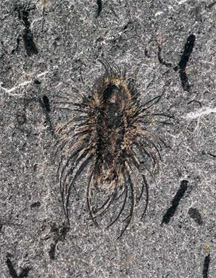
|
||||
|
|
||||
|
|
|
Orthrozanclus: the armored Cambrian slug
03.10.2007 -- Paleontologists have identified a 500-million-year-old slug-like creature species from 11 complete fossils found in the Burgess Shale fossil beds of British Columbia. Cambrian period (543 to 490 million years ago) fossils are prolific in this mountainous region, but complete fossils of this prickly-armor coated marine invertebrate have not been found until now. For decades paleontologists have been wondering to what creature the tiny little spines and shell-like parts belonged. This new animal, named Orthrozanclus reburrus, is about half the size of a potato bug, with a hard front shell, long spines covering its entire body, and shorter spines along the edges. Some of the spines are went, but not broken. Lacking eyes and limbs, this creature most-likely lived at the bottom of the sea, and scooted along the ocean floor searching for bacteria-sized food. The Orthrozanclus shares features with two invertebrate groups called the halkieriids and the wiwaxiids. The halkieriids and wiwaxiids are members of a large group of animals called the lophotrochozoa, which includes mollusks, worms, and brachiopods. A span of about 30 million years during the Cambrian period is manifested in the fossil record with the sudden appearance of many groups of animals which gave rise to many present day animals. Before the Cambrian period, the fossil record shows no precursors of today's animal groups other than microbes. Rather than being classified in the same group as the mollusks, worms, and brachiopods, scientists are now suggesting that the Orthrozanclus, the halkieriids and the wiwaxiids should be in a unique group of their own.
Works Cited: 2. Jeanna Bryner. Ancient pricky bugs discovered. Live Science Animal Domain. http://www.livescience.com/animalworld/070301_hairy_bugs.html. 01 March 2007. Accessed 10 March 2007 Image on this page appears in Science News and on the Live Science web page. Information and photo used for educational purposes under the provisions of the Fair Use Act of 1976.
|
||
|
|
||||
